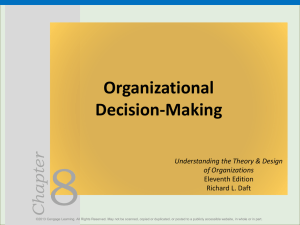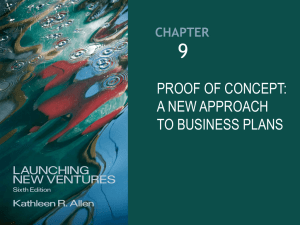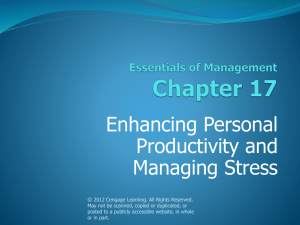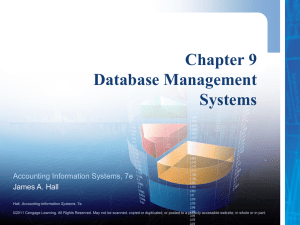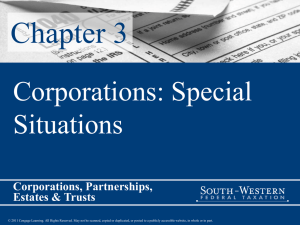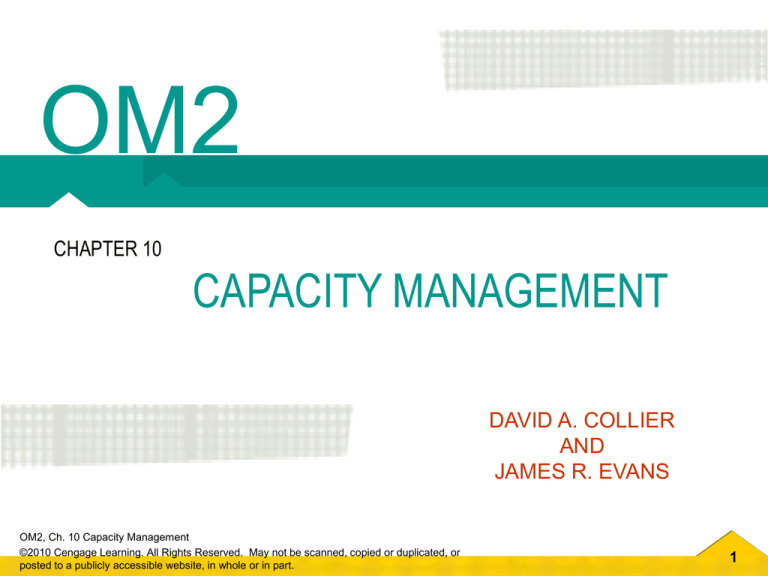
OM2
CHAPTER 10
CAPACITY MANAGEMENT
DAVID A. COLLIER
AND
JAMES R. EVANS
OM2, Ch. 10 Capacity Management
©2010 Cengage Learning. All Rights Reserved. May not be scanned, copied or duplicated, or
posted to a publicly accessible website, in whole or in part.
1
Chapter 10 Learning Outcomes
learning outcomes
LO1 Explain the concept of capacity.
LO2 Describe how to compute and use capacity
measures.
LO3 Describe long-term capacity expansion strategies.
LO4 Describe short-term capacity adjustment strategies.
LO5 Explain the principles and logic of the Theory of
Constraints.
OM2, Ch. 10 Capacity Management
©2010 Cengage Learning. All Rights Reserved. May not be scanned, copied or duplicated, or
posted to a publicly accessible website, in whole or in part.
2
Chapter 10 Capacity Management
If there’s a downside to selling a product users can’t live
without, it’s that customers tend to be unforgiving when
something goes wrong. That’s a lesson BlackBerry maker
Research In Motion (RIM) Ltd., based in Waterloo, Ontario,
learned in 2008 after the company’s popular wireless email
service failed for about three hours – the second large-scale
service disruption in less than a year – leaving so-called
“Crackberry addict”" running for their desktop computers to
read messages. Reports suggested the outage was related to
RIM’s efforts to expand capacity at its central operating center
as its subscriber base increased at the rate of one million new
users every three months.
(continued)
OM2, Ch. 10 Capacity Management
©2010 Cengage Learning. All Rights Reserved. May not be scanned, copied or duplicated, or
posted to a publicly accessible website, in whole or in part.
3
Chapter 10 Capacity Management
Critics argue that RIM is more susceptible to major service
failures because of its centralized network architecture. RIM
designs servers that relay email from a company’s own server
to a network operating center, where it is then handed off to a
wireless carrier and beamed to a subscriber’s device. The
advantage of such a centralized setup is that it gives RIM
more control over the system and its security, even during an
interruption. The downside, however, is that a major problem
at the operating center such as inadequate server and backup
capacity threatens to cascade throughout the entire system,
turning a localized issue into a continent-wide mess.
What do you think? Have you ever experienced problems with a service
because of inadequate labor or equipment capacity?
OM2, Ch. 10 Capacity Management
©2010 Cengage Learning. All Rights Reserved. May not be scanned, copied or duplicated, or
posted to a publicly accessible website, in whole or in part.
4
Chapter 10 Capacity Management
Understanding Capacity
Capacity is the capability of a manufacturing
or service resource such as a facility, process,
workstation, or piece of equipment to
accomplish its purpose over a specified time
period.
OM2, Ch. 10 Capacity Management
©2010 Cengage Learning. All Rights Reserved. May not be scanned, copied or duplicated, or
posted to a publicly accessible website, in whole or in part.
5
Chapter 10 Capacity Management
Understanding Capacity
The resources available to the organization—facilities,
equipment, and labor—how they are organized, and
their efficiency as determined by specific work methods
and procedures determine capacity.
Capacity can be viewed in one of two ways:
1. As the maximum rate of output per unit of time, or
2. As units of resource availability.
OM2, Ch. 10 Capacity Management
©2010 Cengage Learning. All Rights Reserved. May not be scanned, copied or duplicated, or
posted to a publicly accessible website, in whole or in part.
6
Chapter 10 Capacity Management
Solved Problem
An automobile transmission-assembly factory normally
operates two shifts per day, five days per week.
During each shift, 400 transmissions can be completed
under ideal conditions. What is the capacity of this
factory?
Capacity = (2 shifts/day)(5 days/week)
(400 tranmissions/shift)(4 weeks/month)
= 16,000 transmissions/month
OM2, Ch. 10 Capacity Management
©2010 Cengage Learning. All Rights Reserved. May not be scanned, copied or duplicated, or
posted to a publicly accessible website, in whole or in part.
7
Chapter 10 Capacity Management
Key Capacity Issues
• Can the facility, process, or equipment
accommodate new goods and services and
adapt to changing demand for existing goods
and services?
• How large should facility, process, or
equipment capacity be?
• When should capacity changes take place?
OM2, Ch. 10 Capacity Management
©2010 Cengage Learning. All Rights Reserved. May not be scanned, copied or duplicated, or
posted to a publicly accessible website, in whole or in part.
8
Exhibit 10.1
Examples of Short- and Long-Term Capacity Decisions
OM2, Ch. 10 Capacity Management
©2010 Cengage Learning. All Rights Reserved. May not be scanned, copied or duplicated, or
posted to a publicly accessible website, in whole or in part.
9
Chapter 10 Capacity Management
Understanding Capacity
Economies of scale are achieved when the
average unit cost of a good or service decreases as
the capacity and/or volume of throughput
increases.
Diseconomies of scale occur when the average
unit cost of the good or service begins to increase
as the capacity and/or volume of throughput
increases.
OM2, Ch. 10 Capacity Management
©2010 Cengage Learning. All Rights Reserved. May not be scanned, copied or duplicated, or
posted to a publicly accessible website, in whole or in part.
10
Chapter 10 Capacity Management
Understanding Capacity
A focused factory is a way to achieve economies
of scale without extensive investments in facilities
and capacity by focusing on a narrow range of
goods or services, target market segments, and/or
dedicated processes to maximize efficiency and
effectiveness.
OM2, Ch. 10 Capacity Management
©2010 Cengage Learning. All Rights Reserved. May not be scanned, copied or duplicated, or
posted to a publicly accessible website, in whole or in part.
11
Chapter 10 Capacity Management
Understanding Capacity
Safety capacity (often called the capacity
cushion) is an amount of capacity reserved for
unanticipated events, such as demand surges,
materials shortages, and equipment breakdowns.
Average safety capacity (%)
= 100% − Average resource utilization % [10.1]
OM2, Ch. 10 Capacity Management
©2010 Cengage Learning. All Rights Reserved. May not be scanned, copied or duplicated, or
posted to a publicly accessible website, in whole or in part.
12
Exhibit 10.2
The Demand versus Capacity Problem Structure
OM2, Ch. 10 Capacity Management
©2010 Cengage Learning. All Rights Reserved. May not be scanned, copied or duplicated, or
posted to a publicly accessible website, in whole or in part.
13
Chapter 10 Capacity Management
Capacity Measurement in Job Shops
• In a job shop, setup time can be a
substantial part of total system capacity.
Capacity Required (Ci) = Setup Time (Si)
+ [Processing Time (Pi) x Order Size (Qi)]
= Si + [(Pi)(Qi )]
OM2, Ch. 10 Capacity Management
©2010 Cengage Learning. All Rights Reserved. May not be scanned, copied or duplicated, or
posted to a publicly accessible website, in whole or in part.
[10.2]
14
Chapter 10 Capacity Management
Solved Problem
• Ham’s Dental Office (Exhibits 10.3 and 10.4)
illustrates these calculations using a dental
procedure mix.
• Setup times normally represent a substantial
percentage of the total capacity of most job
shops. Every effort must be made to reduce
setup time to the lowest possible amount so as
to “free up capacity” for creating output.
OM2, Ch. 10 Capacity Management
©2010 Cengage Learning. All Rights Reserved. May not be scanned, copied or duplicated, or
posted to a publicly accessible website, in whole or in part.
15
Exhibit 10.3
Dental Office Procedures and Times for Today
OM2, Ch. 10 Capacity Management
©2010 Cengage Learning. All Rights Reserved. May not be scanned, copied or duplicated, or
posted to a publicly accessible website, in whole or in part.
16
Exhibit 10.4
*Example
Dental Office Demand-Capacity Analysis
computation: C = Si + Pi × Qi) = 15 + 15 + (90 × 2) = 210 minutes, assuming a setup for each patient.
OM2, Ch. 10 Capacity Management
©2010 Cengage Learning. All Rights Reserved. May not be scanned, copied or duplicated, or
posted to a publicly accessible website, in whole or in part.
17
Chapter 10 Capacity Management
Long-Term Capacity Strategies
• In developing a long-range capacity plan, a
firm must make the basic economic trade-off
between the cost of capacity and the
opportunity cost of not having adequate
capacity.
• Long-term capacity planning must be closely
tied to the strategic direction of the
organization—what products and services it
offers.
OM2, Ch. 10 Capacity Management
©2010 Cengage Learning. All Rights Reserved. May not be scanned, copied or duplicated, or
posted to a publicly accessible website, in whole or in part.
18
Chapter 10 Long-Term Capacity Strategies
Long-Term Capacity Strategies
• Complementary goods and services can be
produced or delivered using the same resources
available to the firm, but whose seasonal
demand patterns are out of phase with each
other.
• Complementary goods or services balance
seasonal demand cycles and therefore use the
excess capacity available, as illustrated in Exhibit
10.5.
OM2, Ch. 10 Capacity Management
©2010 Cengage Learning. All Rights Reserved. May not be scanned, copied or duplicated, or
posted to a publicly accessible website, in whole or in part.
19
Exhibit 10.5
Seasonal Demand and Complementary Goods or Services
OM2, Ch. 10 Capacity Management
©2010 Cengage Learning. All Rights Reserved. May not be scanned, copied or duplicated, or
posted to a publicly accessible website, in whole or in part.
20
Chapter 10 Capacity Management
Briggs and Stratton
Briggs & Stratton is the world’s largest producer of aircooled gasoline engines for outdoor power equipment.
The company designs, manufacturers, markets, and
services these products for original equipment
manufacturers worldwide. These engines are primarily
aluminum alloy gasoline engines ranging from 3 through
25 horsepower. Briggs & Stratton is a leading designer,
manufacturer, and marketer of portable generators, lawn
mowers, snow throwers, pressure washers, and related
accessories. It also provides engines for manufacturers
of other small engine-driven equipment such as
snowmobiles, go-karting, and jet skis.
(continued)
OM2, Ch. 10 Capacity Management
©2010 Cengage Learning. All Rights Reserved. May not be scanned, copied or duplicated, or
posted to a publicly accessible website, in whole or in part.
21
Chapter 10 Capacity Management
Briggs and Stratton
The complementary and diverse original
equipment markets for Briggs & Stratton
engines allows factory managers to plan
equipment and labor capacities and schedules in
a much more stable operating environment. This
helps minimize manufacturing costs, stabilize
workforce levels, and even out volumes so that
assembly lines can be used in a more efficient
fashion
OM2, Ch. 10 Capacity Management
©2010 Cengage Learning. All Rights Reserved. May not be scanned, copied or duplicated, or
posted to a publicly accessible website, in whole or in part.
22
Chapter 10 Capacity Expansion Options
Long-Term Capacity Strategies
Four basic strategies for expanding capacity over
some fixed time horizon:
1. One large capacity increase (Exhibit 10.6a).
2. Small capacity increases that match average
demand (Exhibit 10.6b).
3. Small capacity increases that lead demand
(Exhibit 10.6c).
4. Small capacity increases that lag demand (Exhibit
10.6d).
OM2, Ch. 10 Capacity Management
©2010 Cengage Learning. All Rights Reserved. May not be scanned, copied or duplicated, or
posted to a publicly accessible website, in whole or in part.
23
Exhibit 10.6
OM2, Ch. 10 Capacity Management
©2010 Cengage Learning. All Rights Reserved. May not be scanned, copied or duplicated, or
posted to a publicly accessible website, in whole or in part.
Capacity Expansion Options
24
Chapter 10 Capacity Management
Short Term Capacity Adjustment Decisions
•
•
•
•
•
Add or share equipment: lease equipment as needed
or set up a partnership arrangement with capacity
sharing. Examples: mainframe computers, CAT scanner,
farm equipment.
Sell unused capacity: sell idle capacity to outside
buyers and even competitors. Examples: computing
capacity, perishable hotel rooms.
Change labor capacity and schedules: short term
changes in work force levels. Examples: overtime, extra
shifts, temporary employees, outsourcing.
Change labor skill mix: hiring the right people.
Shift work to slack periods
OM2, Ch. 10 Capacity Management
©2010 Cengage Learning. All Rights Reserved. May not be scanned, copied or duplicated, or
posted to a publicly accessible website, in whole or in part.
25
Chapter 10 Capacity Management
Managing Capacity by Shifting and Stimulating Demand
•
•
•
•
•
Vary the price of goods or services: price is the most
powerful way to influence demand.
Provide customers information: best times to call or
visit.
Advertising and promotion: a vital role on influencing
demand; promotions are strategically distributed to
increase demand during periods of low sales or excess
capacity.
Add peripheral goods and/or services: change
demand during slack periods.
Provide reservations: a promise to provide a good or
service at some future time and place.
OM2, Ch. 10 Capacity Management
©2010 Cengage Learning. All Rights Reserved. May not be scanned, copied or duplicated, or
posted to a publicly accessible website, in whole or in part.
26
Chapter 10 Capacity Management
If You Make a Reservation, Be Sure to Show Up!
The following sign was seen on a doctor’s reception
desk:
NO-SHOW POLICY
Beginning August 15, 2008 we will be charging a $30
fee to patients who fail to keep their scheduled
appointments. To avoid this fee, patients need to cancel
their appointment 24 hours ahead. This fee is not
covered by insurance and will be the patient’s
responsibility.
What does this statement demonstrate about the nature
of service demand and capacity?
OM2, Ch. 10 Capacity Management
©2010 Cengage Learning. All Rights Reserved. May not be scanned, copied or duplicated, or
posted to a publicly accessible website, in whole or in part.
27
Chapter 10 Capacity Management
Revenue Management Systems
A revenue management system (RMS) - often
called yield management - consists of dynamic
methods to forecast demand, allocate perishable
assets across market segments, decide when to
overbook and by how much, and determine
what price to charge different customer (price)
classes.
Revenue management systems consist of
forecasting, allocation, overbooking, and pricing.
OM2, Ch. 10 Capacity Management
©2010 Cengage Learning. All Rights Reserved. May not be scanned, copied or duplicated, or
posted to a publicly accessible website, in whole or in part.
28
Chapter 10 Capacity Management
Theory of Constraints
The Theory of Constraints (TOC) is a set of
principles that focuses on increasing total process
throughput by maximizing the utilization of all
bottleneck work activities and workstations.
• Throughput: amount of money generated
per time period through actual sales.
• Constraint: anything that limits an
organization from moving toward or achieving
its goal.
OM2, Ch. 10 Capacity Management
©2010 Cengage Learning. All Rights Reserved. May not be scanned, copied or duplicated, or
posted to a publicly accessible website, in whole or in part.
29
Chapter 10 Capacity Management
Theory of Constraints
• A physical constraint is associated with the
capacity of a resource (e.g., machine, employee).
• A bottleneck work activity is one that
effectively limits capacity of the entire process.
• A nonbottleneck work activity is one in which
idle capacity exists.
• A nonphysical constraint is environmental or
organizational (e.g., low product demand or an
inefficient management policy or procedure).
OM2, Ch. 10 Capacity Management
©2010 Cengage Learning. All Rights Reserved. May not be scanned, copied or duplicated, or
posted to a publicly accessible website, in whole or in part.
30
Exhibit 10.7
Basic Principles of the Theory of Constraints
OM2, Ch. 10 Capacity Management
©2010 Cengage Learning. All Rights Reserved. May not be scanned, copied or duplicated, or
posted to a publicly accessible website, in whole or in part.
31
Chapter 10 Capacity Management
David Christopher, Orthopedic Surgeon, Case Study
1. What is the clinic’s current weekly workload?
2. Should the clinic hire more surgeons, and if so, how
many?
3. What other options and changes could be made to
maximize patient throughput and surgeries, and
therefore revenue, yet not comprise on the quality of
medical care?
4. What are your final recommendations? Explain your
reasoning.
OM2, Ch. 10 Capacity Management
©2010 Cengage Learning. All Rights Reserved. May not be scanned, copied or duplicated, or
posted to a publicly accessible website, in whole or in part.
32


